The AMD Ryzen 7 5700G, Ryzen 5 5600G, and Ryzen 3 5300G Review
by Dr. Ian Cutress on August 4, 2021 1:45 PM ESTIntegrated Graphics Tests
Finding 60+ FPS
Never mind 30 frames per second, if we want gaming to be smooth, we look for true 60 FPS gaming. It's going to be a benchmark for any integrated graphics solution, but one question is if games are getting more difficult to render faster than integrated graphics is improving. Given how we used to talk about 30-40 FPS on integrated graphics before Ryzen, it stands to reason that the base requirements of games is only ever getting worse. To meet that need, we need processors with a good level of integrated oomph.
So here are a series of our tests that meet that mark. Unfortunately most of them are 720p Low (or worse).
A full list of results at various resolutions and settings can be found in our Benchmark Database.
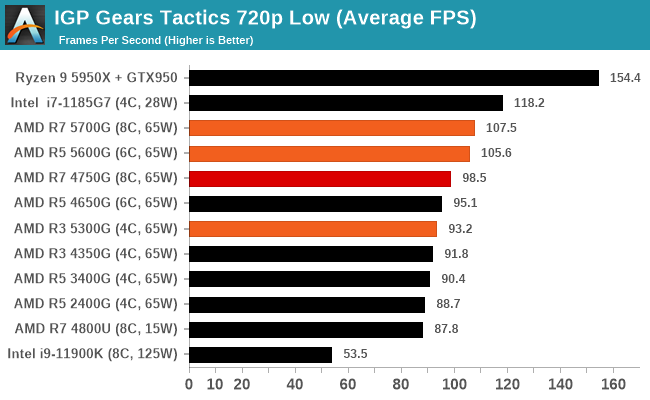
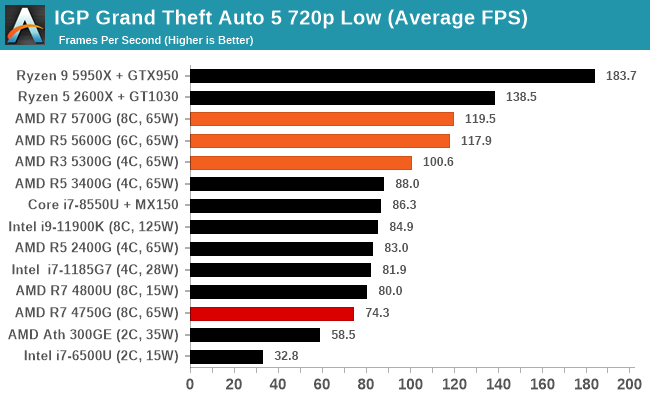
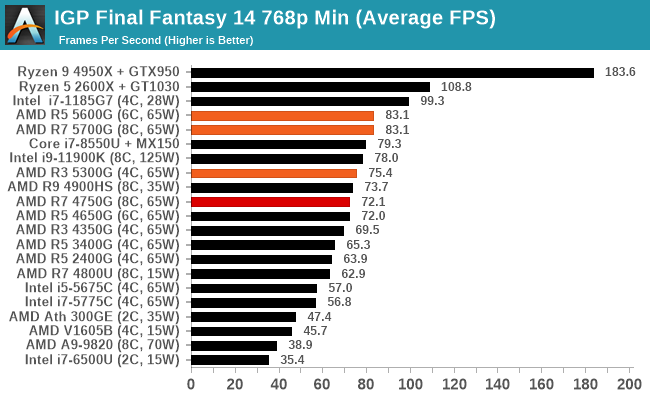

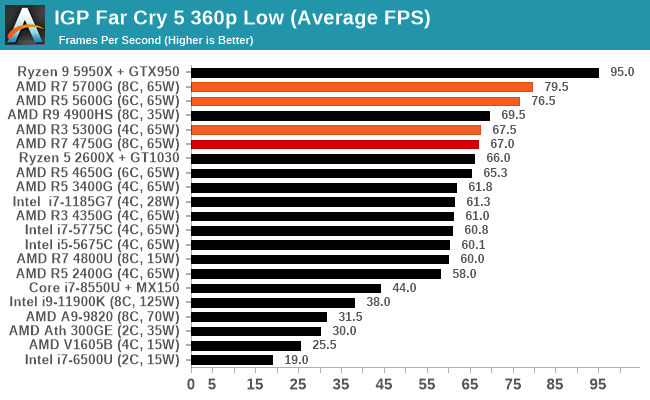
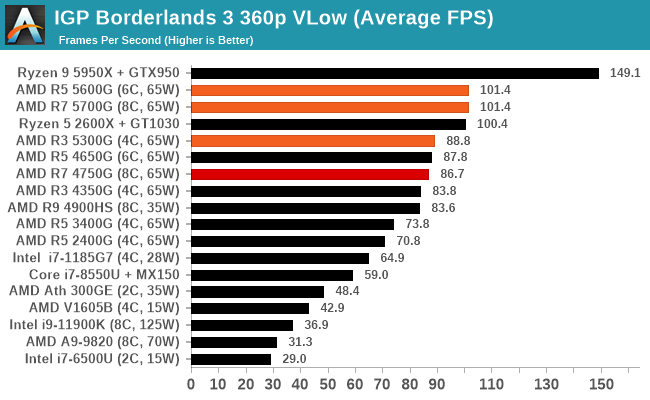
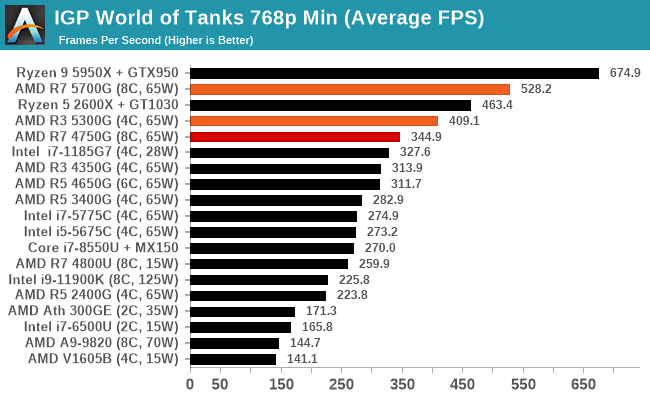
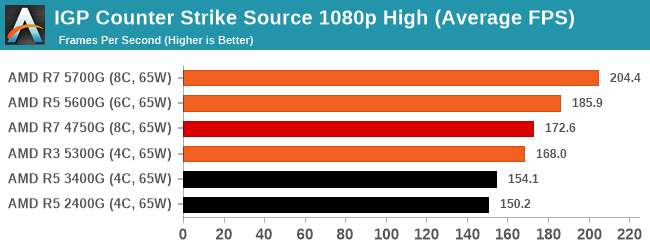
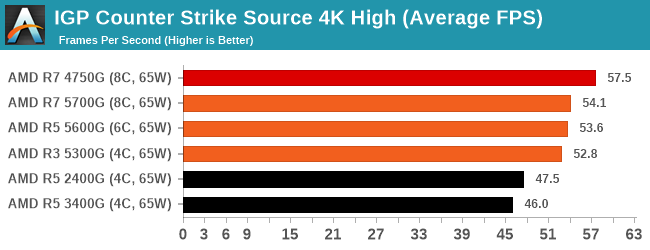
These last couple of games here, World of Tanks and CS:Source are getting on in age a bit. Playing at 1080p High/Max on both is easily done, but we cranked Source up to 4K and we're not even getting 60 frames per second. The previous generation R7 even beat out the new APUs here, probably indicating that the previous generation had more power going into the GPU and the new models are balanced towards the CPU cores a bit more. It works in some games clearly, and 1080p resolutions, but not here at 4K.


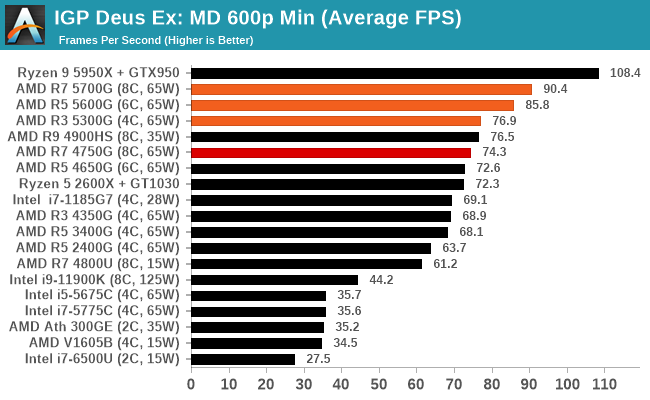








135 Comments
View All Comments
Wereweeb - Wednesday, August 4, 2021 - link
The bottleneck is memory bandwidth. DDR5 will raise the iGPU performance roof by a substantial amount, but I hope for something like quad-channel OMI-esque Serial RAM.abufrejoval - Saturday, August 7, 2021 - link
I'd say so, too, but...I have just had a look at a Kaveri A10-7850K with DDR3-2400 (100 Watt desktop), a 5800U based notebook with LPDDR4 (1333MHz clock) and a Tiger Lake NUC with an i7-1165G7 with DDR4-3200.
The memory bandwidth differences between the Kaveri and the 5800U is absolutely minor, 38.4 GB/s for the Kaveri vs. 42.7GB/s for Cezanne (can't get the TigerLake figures right now, because it's running a Linux server, but it will be very similar).
The Kaveri and Cezanne iGPUs are both 512 shaders and apart from architectural improvements very much differ in clocks 720MHz vs. 2000MHz. The graphics performance difference on things like 3DMark scale pretty exactly with that clock difference.
Yet when Kaveri was launched, Anandtech noted that the 512 shader A10 variant had trouble to do better then the 384 shader APUs, because only with the very fastest RAM it could make these extra shaders pump out extra FPS.
When I compared the Cezanne iGPU against the TigerLake X2, both systems at tightly fixed 15 and 28Watts max power settings, TigerLake was around 50% faster on all synthetic GPU benchmarks.
The only explanation I have for these fantastic performance increases is much larger caches being very smartly used by breaking down GPU workloads to just fit within them, while prefetching the next tile of bitmaps into the cache in the background and likewise pushing processed tiles to the framebuffer RAM asynchronously to avoid stalling GPU pipelines.
And yet I'd agree that there really isn't much wiggling room left, you need exponential bandwidth to cover square resolution increases.
abufrejoval - Saturday, August 7, 2021 - link
need edit!Is TigerLake Xe, not X2.
Another data point:
I also have an NUC8 with an 48EU (+128MB eDRAM) Iris 655 i7 and a NUC10 with an 24EU "no Iris" UHD i7. Even with twice the EUs and the extra eDRAM (which I believe can be used in parallel to the external DRAM), the Iris only gets a 50% performance increase.
The the 96EU TigerLake iGPU is doing so much better (better than linear scale over UHD) while it actually has somewhat less bandwidth (and higher latency) than the 50GB/s eDRAM provides for the 48EU Iris.
bwj - Wednesday, August 4, 2021 - link
Why are these parts getting stomped by Intel and their non-graphics Ryzen siblings?bwj - Wednesday, August 4, 2021 - link
Meh, meant to say "in browser benchmarks". Browser is an important workload (for me at least) and the x86 crowd is already fairly weak versus Apple M1, so I'm not ready to throw away another 30% of browser perf.Lezmaka - Wednesday, August 4, 2021 - link
There are only 3 browser tests and for two of them the 5700G is within a few percent of the 11700K. But otherwise, it's because these are laptop chips with higher TDP. The 11700K has a TDP of "125W" but hit 277W where the 5700G has a TDP of 65W and maxed out at 88W.Makaveli - Wednesday, August 4, 2021 - link
There is something up with the browser scores here anyways compared to what you see in the forum. All the post with similar desktop cpu's in that thread post much high scores than what is listed in the graph. I'm not sure its old browser version being used to keep scores inline with older reviews or something.https://forums.anandtech.com/threads/how-fast-is-y...
abufrejoval - Wednesday, August 4, 2021 - link
When you ask: "Why don't they release the four core variant?" you really should be able to answer that yourself!There are simply not enough defective chips to make it viable just yet. Eventually they may accumulate, but as long as they are trying to produce an 8 core chip, 4 and 6 cores should remain the exception not the rule.
I'd really like to see them struggle putting the lesser chips out there, because it means my 8/16(/32/64) core chips are rock solid!
I would have liked to see full transistor counts of the 5800X and the 5700U side by side. My guess would be that the Cezanne dies even at 50% cache have more transistors overall, meaning you are getting many more pricey 7nm transistors per € on these APUs and should really pay a markup not a discount.
Well even the GF IO die fab capacity might have customers lined up these days, but in normal times those transistors should be much more commodity and cheaper and have the APU cost more in pure foundry (less in packaging) than the X-variants, while AMD wants to fit it into a below premium price slot where it really doesn't belong.
nandnandnand - Wednesday, August 4, 2021 - link
If AMD boosted chiplet/monolithic core count to 12, maybe 6 cores could become the new minimum with 10-core being a possibility. But it doesn't look like they plan to do that.Wereweeb - Wednesday, August 4, 2021 - link
These might have been a stockpile of dies that were rejected for laptop use (High power consumption @ idle?) and they're being dumped into the market after AMD satisfied OEM demand for APU's.Plus, considering that one of the main shortages is for substrates, it's possible that the substrate for the APU's is different - cheaper, higher volume, etc... as it doesn't need to interconnect discrete chiplets.